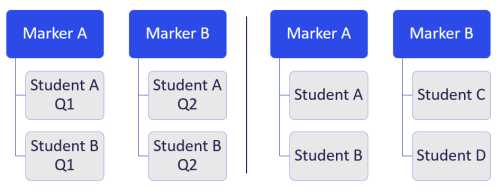Success using a marking team
20 September 2023
Using a marking team can reduce total marking time, especially for large courses, enabling the efficient return of student assessment. However, actions need to be taken to ensure success.
Regardless of the size of your marking team, the following actions will help to ensure success and minimise aspects of marking that can lead to student questions and complaints, including lack of consistency and lack of feedback.
When choosing your marker/s, consider their experience in terms of marking the type of assessment you have, marking in the online platform you are using (Grade or Turnitin), and providing the level of annotation or feedback that you are looking for. The more experienced the marker, the less time you will need to spend training them. Remember there are online marking videos on Teaching at Lincoln under Assessment Support that you can provide to your marker/s – these cover a variety of aspects including annotations and feedback.
Setting your marker/s up for success is important. This requires you to discuss your expectations with them about standards, feedback, annotations, and timeframe. Provide examples of what you are looking for and spend time discussing your marking criteria. This can be done in a meeting, or you could record a video. Checking and re-checking is important for ensuring your expectations are being met and there is marking consistency. One approach you could use is "mark, review, discuss, re-mark". Ask your marker to mark 5-10 assessments (either chosen at random or chosen by you for their variation), review their marking, discuss any variations from your expectations, and if necessary, ask them to re-mark. Once you are confident that your expectations are being met, ask your marker/s to proceed with marking the remainder of the assessment submissions allocated to them. Remember to review their marking again at the end.
Consistency is aided by using detailed and specific performance criteria, for example, a marking rubric. A marking rubric also provides feedback to students, both before and after they submit. The use of ‘frequently used comments’ will provide some consistency with the feedback students are receiving and speed up the marking process. How you allocate the marking will also impact the ability of your marker/s to be consistent. Two possible marking allocations are shown in the image below. Allocating questions or components of the assessment to different markers (the depiction on the left) will lead to more consistent marking than allocating submissions to different markers (the depiction on the right).

If you are using an Assignment activity on your Akoraka | Learn course page, see our videos on Teaching at Lincoln under Assessment Support for tips on tracking marking and marking allocation.
If you would like further support, please email Teaching Quality or come along to one of our drop-in sessions.

